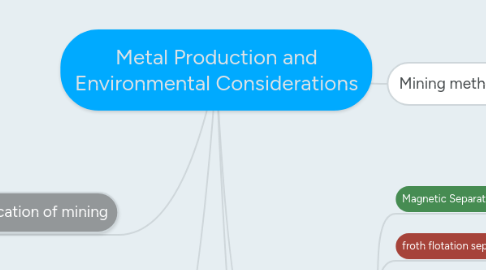
1. Copper Production
1.1. Matte Smelting
1.1.1. The ore is roasted at a temperature lower than the melting point of copper producing slag and material known matte
1.2. Converting to blister copper
1.2.1. The molten matte is transferred to the converter furnace which operates on similar principles to the basic oxygen furnace
1.3. Refining by electrolysis
1.3.1. Electric Current passes through the copper in a special solution will remove final impurities
2. Environmental implication of mining
2.1. Common environmental impacts of mining include: erosion formation of sinkholes loss of biodiversity contamination of soil, groundwater, surface water by chemicals from mining processes
2.2. The tailings left after the valuable part of an ore is taken can often contain undesirable elements including arsenic, mercury and sulphuric acid.
3. Mining methods
3.1. Metals must be extracted from mineral compounds known as ores which we find in the earth’s crust
3.2. Dredging
3.2.1. collecting valuable ores from the sea bed floor with waste material returned to the sea bed
3.3. Surface mining
3.3.1. removing overburden from the surface to reveal the ore of value
3.4. Underground mining
3.4.1. involves digging tunnels or shafts to reach ore deposits buried deep in the earth’s crust.
4. Seperation
4.1. Magnetic Separation
4.1.1. only works for ferromagnetic metals
4.2. froth flotation separation
4.2.1. chemical agents which float and are attracted to the desired metal are swirled in a aerated tank
4.3. Smelting
4.3.1. the ore is heated, melted, impurities are removed and the metal is formed
4.3.2. Blast Furnace
4.3.2.1. Impurities in the molten metal combine with oxygen to form oxides which are collected in a limestone based slag.
4.3.2.2. The blast furnace produces ingots of pig iron which contain around 3 - 4.5% carbon
4.3.2.3. Small amounts are cast into new shapes and classified as cast iron
